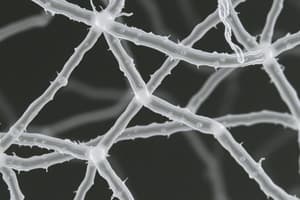Podcast
Questions and Answers
What is the function of the cell membrane in a cell?
What is the function of the cell membrane in a cell?
- Produces energy for the cell
- Stores genetic material
- Regulates the movement of materials in and out of the cell (correct)
- Performs protein synthesis
Which organelle is responsible for energy production in a eukaryotic cell?
Which organelle is responsible for energy production in a eukaryotic cell?
- Mitochondria (correct)
- Ribosomes
- Endoplasmic reticulum
- Nucleus
What is the main process by which cells replicate to produce two identical daughters?
What is the main process by which cells replicate to produce two identical daughters?
- Energy synthesis
- Lipid synthesis
- Cell division or mitosis (correct)
- Protein folding
Which statement best describes the function of the nucleus in a cell?
Which statement best describes the function of the nucleus in a cell?
What role do ribosomes play in a eukaryotic cell?
What role do ribosomes play in a eukaryotic cell?
What are some categories used to classify cell shapes?
What are some categories used to classify cell shapes?
Who were some of the scientists credited with the discovery of cells in the 17th century?
Who were some of the scientists credited with the discovery of cells in the 17th century?
What is the approximate average size of animal cells?
What is the approximate average size of animal cells?
Which component is NOT typically found in cells?
Which component is NOT typically found in cells?
What makes the shape of eukaryotic cells more varied compared to other cells?
What makes the shape of eukaryotic cells more varied compared to other cells?
Flashcards
Cell Shape
Cell Shape
Cells come in various forms such as spherical and rod-shaped, but eukaryotic cells can have more varied shapes.
Discovery of Cells
Discovery of Cells
The discovery of cells was made possible by early microscopes in the 17th century.
Cell Size
Cell Size
Cells range from 1 micrometer to over 1 meter, but most animal cells average around 10 micrometers.
Cell Membrane
Cell Membrane
Signup and view all the flashcards
Cell Division
Cell Division
Signup and view all the flashcards
Cytoplasm
Cytoplasm
Signup and view all the flashcards
Cell Organelles
Cell Organelles
Signup and view all the flashcards
Cell Nucleus
Cell Nucleus
Signup and view all the flashcards
Study Notes
Cell Shape, Discovery, and Size
The intricate world of cells, the fundamental units of life, encompasses a myriad of shapes, sizes, and functions. Let's delve into these three aspects to gain a better understanding of this microscopic marvel.
Cell Shape
Cells are often categorized by their shapes, which include spherical, rod-shaped, cube-shaped, and flat sheet-like forms. However, the complex architecture of eukaryotic cells, such as animal and plant cells, tends to be more varied and irregular due to the presence of specialized organelles.
Discovery of Cells
The concept of cells was not fully understood until the 17th century, when scientists like Robert Hooke and Anton van Leeuwenhoek first observed them through microscopes. Their observations revolutionized the understanding of life, leading to the discovery of the cell's structure and function.
Cell Size
Cells exhibit a wide range of sizes, from microscopic bacteria (approximately 1 micrometer or 0.001 millimeters) to giant cells like a nerve cell in a squid, reaching over 1 meter (39 feet) in length. However, the average size of animal cells is around 10 micrometers, while plant cells are generally larger, around 50-100 micrometers.
Cell Structure
Cells contain three main components: the cell membrane, the nucleus, and the cytoplasm. The cell membrane is a selectively permeable barrier, the nucleus houses the genetic material, and the cytoplasm is a gel-like fluid in which organelles and other cellular components function.
Cell Organelles
Eukaryotic cells contain numerous organelles, each with a specific role in cellular function. Some of the most common organelles include the nucleus, mitochondria, endoplasmic reticulum, and ribosomes, each playing crucial roles in cellular processes like energy production, protein synthesis, and lipid synthesis.
Cell Membrane
The cell membrane is a phospholipid bilayer with embedded proteins that control the movement of materials in and out of the cell. These proteins act as gatekeepers, signaling molecules, and receptor sites.
Cell Division and Growth
Cell division, also known as mitosis, is the process by which cells replicate to produce two identical daughters. Cells grow and divide in response to various signals, such as nutrient availability, hormonal changes, and damage. This lifecycle ensures that cells are replaced when necessary and that organisms can grow and develop.
Conclusion
The study of cell shape, discovery, and size reveals the vast complexity and diversity of life. Understanding these aspects of cell biology provides valuable insights into the fundamental processes that govern life's intricate web of interactions.
Studying That Suits You
Use AI to generate personalized quizzes and flashcards to suit your learning preferences.




